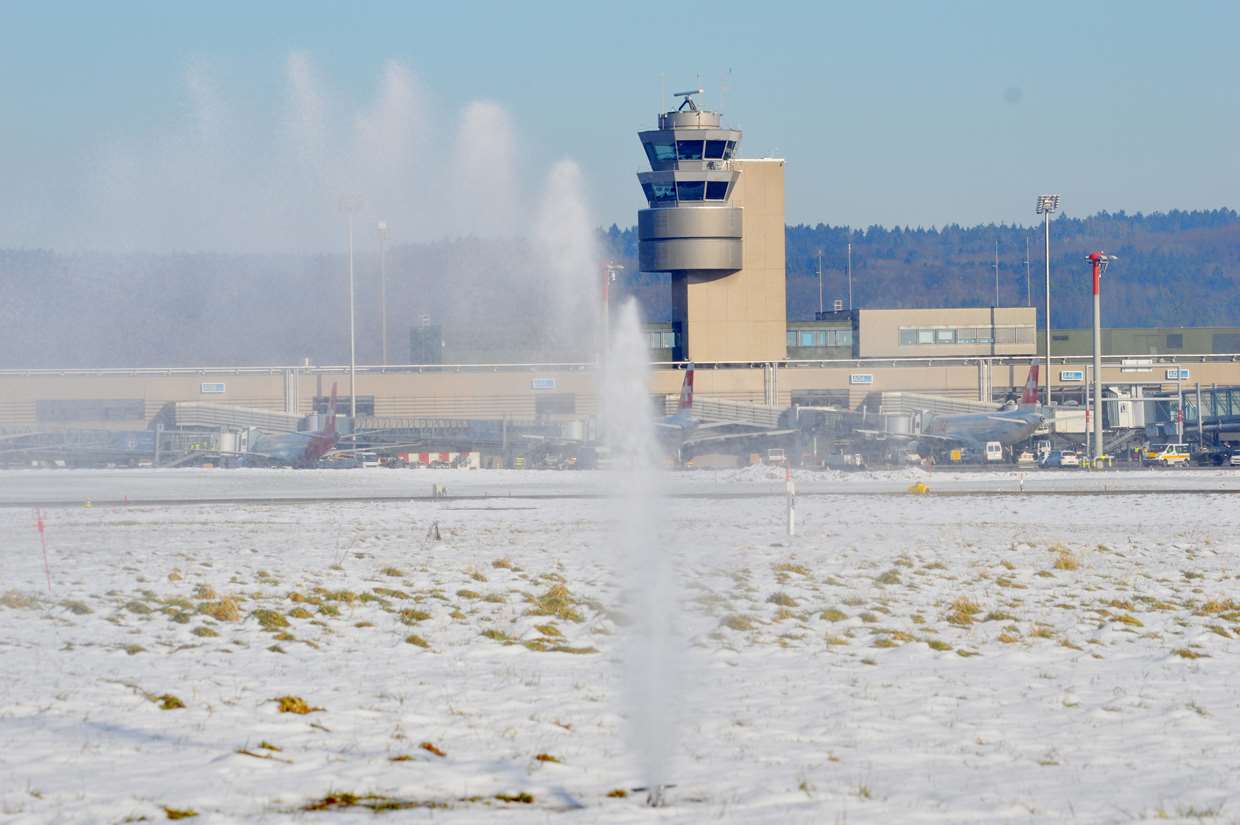Water and water protection
The cycle is closed: drinking and service water obtained from groundwater and rainwater is used responsibly. Waste water is cleaned and fed back into the natural water cycle.
Fresh water
The fresh water used at Zurich Airport comes from three different sources: firstly, drinking water comes from the municipal water supply for the town of Kloten. During the year under review, consumption of this was up 5.5% on the previous year. Secondly, groundwater is pumped away from under the main airport complex to keep dry older buildings that cannot be adequately sealed. Some of this water is used in technical processes and the remainder is channelled into the river Glatt. Thirdly, rainwater is used for flushing some toilets.
|
Consumption of fresh water at Zurich Airport |
|
2018 |
|
2017 |
|
2016 |
|
Drinking water (m 3 ) |
|
700,375 |
|
664,129 |
|
609,053 |
|
Groundwater (m 3 ) |
|
124,119 |
|
123,591 |
|
118,066 |
|
Rainwater (m 3 ) |
|
12,332 |
|
13,005 |
|
12,778 |
|
Total fresh water (m 3 ) |
|
836,826 |
|
800,725 |
|
739,897 |
Drainage plan
In line with its “avoid-separate-treat” approach, Flughafen Zürich AG aims to produce as little sewage as possible. Its general drainage plan includes both measures to ensure drainage systems comply with the law and specifications regarding the operation and maintenance of the existing sewage system.
Domestic and industrial waste water
The various types of waste water that arise at Zurich Airport are each treated in specific ways. Domestic waste water, from toilets or restaurant kitchens for example, is channelled into the local sewage treatment plant at Kloten-Opfikon where it is treated. The sewage plant, which is a joint venture between Flughafen Zürich AG and the municipalities of Kloten and Opfikon, is currently being renovated and extended (while operations continue uninterrupted). Special waste water, from workshops or from aircraft toilets for example, requires pre-treatment on the airport premises before it can likewise be sent to the sewage plant or otherwise appropriately disposed of.
Aircraft and runway de-icing
In order to ensure safe flight operations, in winter it is essential to keep both aircraft and operational areas free of ice. During the winter of 2017/18, 2,152 m3 of de-icing agents (propylene glycol) were used for aircraft de-icing (+12% more than the previous year). A total of 1,580 m3 of liquid de-icing agents (+21%) were required for runways, taxiways and aprons. 329 tonnes of conventional de-icing salts were additionally used on service roads, in the car parks and around the maintenance area. These quantities are considerably higher than the long-term average. However, the quantity of de-icing agents used can vary considerably from one winter to another depending on the amount of precipitation and ambient temperatures.
|
Consumption of de-icing agents at Zurich Airport |
|
2017/2018 |
|
2016/2017 |
|
2015/2016 |
|
Aircraft de-icing agents (m 3 ) |
|
2,152 |
|
1,921 |
|
1,390 |
|
Runway and road de-icing agents, formiate solution (m 3 ) |
|
1,580 |
|
1,301 |
|
901 |
|
Surface de-icing agents, solid (tonnes) |
|
21 |
|
0 |
|
0 |
|
De-icing salts for other surfaces (tonnes) |
|
329 |
|
492 |
|
243 |
|
Untreated carbon washed away (aprons, runway and taxiways, %) |
|
92 |
|
94 |
|
93 |
Treatment of waste water from de-icing operations

The sprinkler system sprays de-icer runoff onto grassed areas.
De-icing aircraft with hot water and propylene glycol as well as spraying potassium formate-based de-icing agents on operating surfaces results in waste water contaminated with carbon compounds. If waste water were to enter natural watercourses untreated, it would remove oxygen from the water and therefore cause problems for aquatic organisms. To prevent this, the waste water is collected and is then treated depending on the level of carbon concentration. Water that is only slightly polluted is first channelled through retention filter basins and then into the Glatt. Medium-contaminated waste water is sprayed over grassed areas using a special sprinkler system. As the water filters down through the soil, the glycol it contains biodegrades completely. Heavily contaminated waste water is treated in the airport’s two distillation plants, where the glycol is concentrated and then supplied as a raw material to industrial companies.
Over the winter of 2017/18, at 92% the amount of collected run-off was on a par with the previous year.
Amount of collected run-off from de-icing operations.

